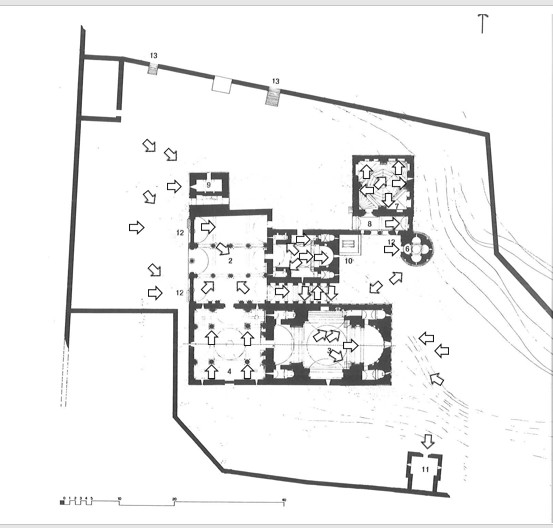Gohar Grigoryan
Sanahin Monastery is located in the village of Sanahin, in the region of Loṙi. The monastery consists of two churches, dedicated to Holy Mother of God and Saint Saviour; several gavit‛s (narthexes); a belfry; a chapel dedicated to St Gregory the Illuminator; a matenadaran (manuscript library); and an auditorium. The Mausoleum of the Zakarid family members and many khatchkars also form part of the monastic complex. Outside the monastery’s walls are several chapels, a fountain, and the twelfth-century bridge of Sanahin, built on the river of Debed by Queen Vaneni.
The oldest building of Sanahin Monastery is the Church of the Holy Mother of God, built in 928-944 during the reign of King Abas I Bagratid (928-953). In its plan, it is a domed hall church, one of the ancient examples of this type. The main church is dedicated to Saint Saviour and was built during the years 957-966 under the patronage of Queen Xosrovanuyš, the spouse of King Ašot III Bagratid (953-977). The sculptured portrait on the eastern wall of the church represents the patron’s sons, Gurgen (Kiwrikē) and Smbat, holding in their hands the model of the church. The corresponding inscription reads: “King Kiwrikē, King Smbat”. Given that during the time of the church’s construction Smbat and Gurgen were still children and that the inscription is not placed symmetrically within the frame, it is possible that it was added later, when the Bagratid brothers were already holding their royal titles: Smbat as king of Armenia, and Gurgen as subordinate king of Tašir-Joraget. At Haghbat Monastery, commissioned two decades later by the same royal family, another relief portrait of the two brothers appears, representing them and their new political status, expressed through their robes and headgear.
In 1061, a chapel was built dedicated to St Gregory the Illuminator. The small chapel has a circular shape from the exterior, but, in its interior, has the traditional cross-shape plan. Close to the Chapel of St Gregory, Hranuš, the daughter of King Davit Anhołin of Tašir-Joraget (989-1050), built the matenadaran of Sanahin, one of the most famous manuscript libraries of medieval Armenia, in 1063. It is a rectangular building with an unusual vaulting system. Along the interior walls, between richly decorated columns, are holes of different shapes where the books were kept.
The first gavit of Sanahin Monastery was built in 1181 by the architect Žamhayr in the western side of the Church of Saint Saviour. It is a big hall with four large columns and a central cupola, which allows light to enter the space. The second gavit, known as Big gavit‛, was built in 1211 on the western side of the Church of the Holy Mother of God by the Prince Vač‛e Vač‛utean, a high military officer of Zak‛arē Zak‛arid. Besides these two gavits, there is also an additional antechamber, the extension of which leads to another structure, which is situated between the churches of St Saviour and Theotokos. This structure is known as the Auditorium of Grigor Magistros Pahlavuni (990-1058), a prominent scholar, philosopher and political and military functionary of the eleventh century, who, as attested in textual sources, gave lectures at the Sanahin academy. The three-level belfry was also built in the thirteenth century.
Interactive Plan

Image Gallery
Bibliography
- Brosset M.-F., ‘Sur les couvents armeniens d’Haghbat et de Sanahin’, in Melanges asiatiques tires
du Bulletin de l’Academie imperiale des sciences de St.-Petersbourg IV (1860-1863) – livraisons 5 et
6 (1863), 605-628. - Cuneo P., ‘Les modeles en pierre de l’architecture armenienne’, in Revue des Etudes armeniennes
6 (1969), 201-231. - Eastmond A. & Jones L., ‘Robing, Power, and Legitimacy in Armenia and Georgia’, in Robes and
Honor: The Medieval World of Investiture, edited by Stewart Gordon, New York 2001, 155-157. - Ghalpaktchian H., ‘Dproc‛nern u gratnerǝ miǰnadaryan Hayastanum (Schools and Libraries in
Medieval Armenia)’, in Ēǰmiacin Monthly 22 (1963), 21-28. - Ghalpaktchian O. Kh. & Alpago-Novello A., Sanahin, Documenti di architettura armena 3, Milan
1970. - Harut‛yunyan V., Haykakan čartarapetut‛yan patmut‛yun (History of Armenian Architecture),
Yerevan 1992, 246-249, 295-298. - Hovhannissian C., Sanahin-Hakhpat, Yerevan 1978 (in Armenian, French and Russian).
Łafadaryan K., Sanahni vank‛ǝ yev nra arjanagrut‛yunnerǝ (The Sanahin Monastery and Its
Inscriptions), Yerevan 1957. - Łafadaryan K., ‘Sanahni vank‛ (Sanahin Monastery)’, in Christian Armenia Encyclopedia, Yerevan
2002, 885-890. - Marut‛yan T., ‘Sanahni Amenap‛rkič‛ ekełeč‛u kaṙuc‛man žamanaki harc‛i šurǰ (On the Date of
Construction of the Saint Savior Church in Sanahin)’, Historical-Philological Journal 1 (2001), 190-
201. - Yarut‛iwnean I., Sanahin, Tbilisi 1898 (first published in Ethnographic Journal 1 (1898), 273-315).
Inscriptions
- Barxudaryan S., Łafadaryan K., & Sałumyan S., Corpus Inscriptionum Armenicarum, Liber IX: Region
of Loṙi, Yerevan 2012, 21-120. - Łafadaryan K., Sanahni vank‛ǝ yev nra arjanagrut‛yunnerǝ (The Sanahin Monastery and Its
Inscriptions), Yerevan 1957.


